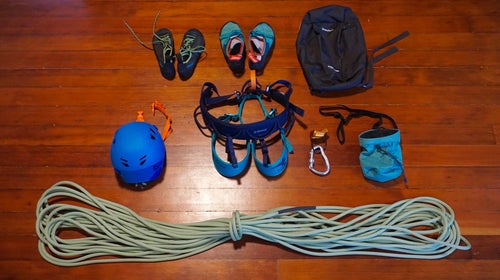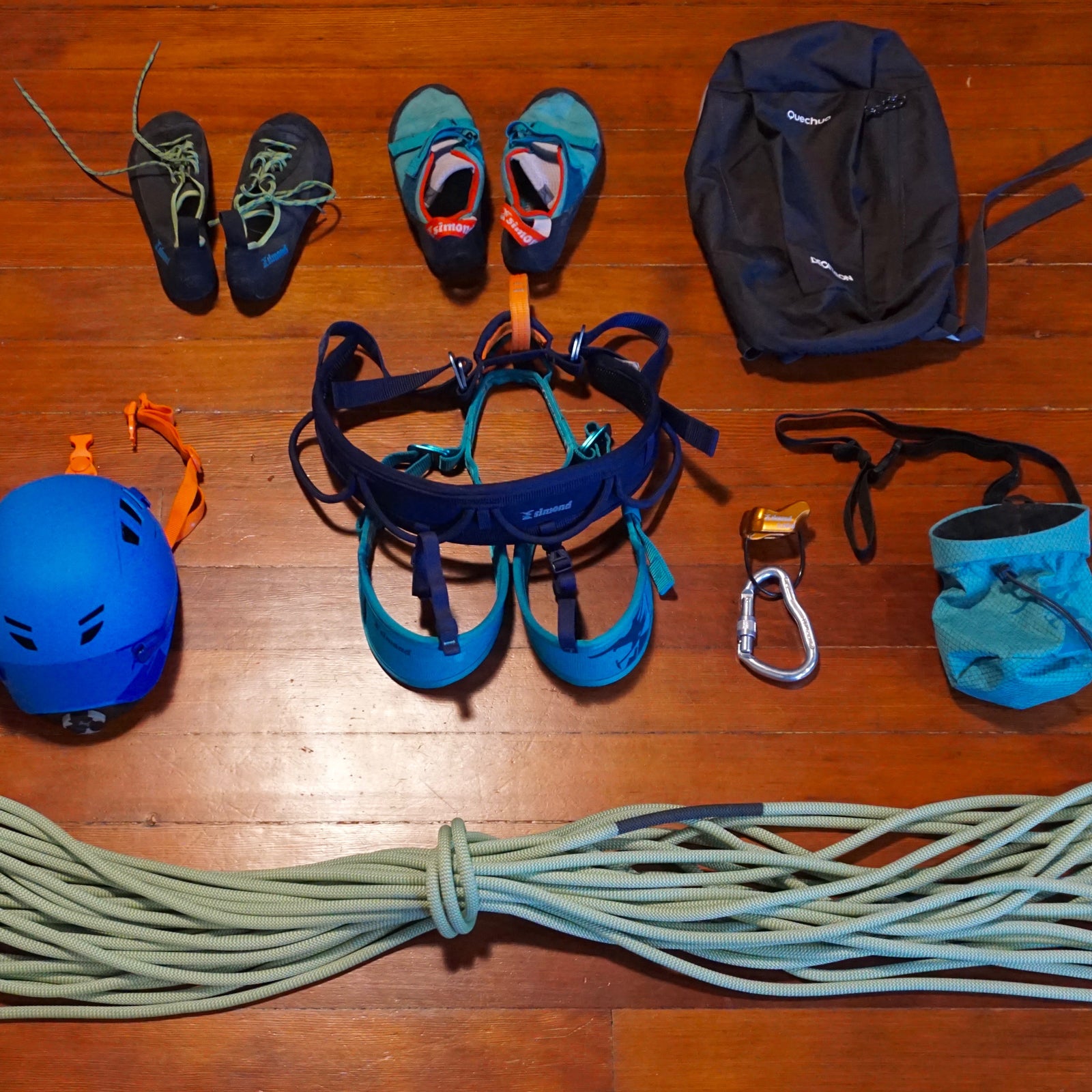When it comes to activities that require gear to get started, climbing generally isnÔÇÖt the most expensive outdoor╠řsportÔÇöbut itÔÇÖs also not the cheapest. Putting together a full gym kit, with shoes, chalk, a chalk bag, harness, belay device, and locking carabiner, can easily amount╠řto over $200.
Decathlon is trying to make the outdoors more accessible with its╠řaffordable╠řgear. The French company operates its own in-house brands,╠řsuch as Quechua (hiking and camping), ╠ř(paddle sports), and ╠ř(climbing and mountaineering). The Simond line touts for $45, for $55, and a for $70. While some of these products arenÔÇÖt jaw-droppingly inexpensive, their prices are lower╠řthan those of most╠řname brands. ThereÔÇÖs a difference between low-cost and cheap, though, so I decided to test out the gearÔÇÖs technical chops.
For this test, I focused primarily on DecathlonÔÇÖs least expensive options, to find╠řbudget-friendly beginner climbing gear. I tested these products for a month, climbing three to four times a week both indoors and out,╠řbouldering, top-roping, and lead-climbing.╠ř
Shoes ($45)
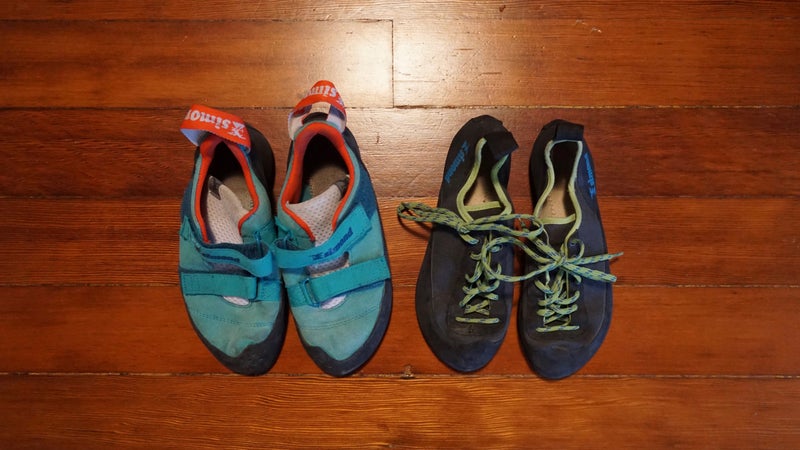
SimondÔÇÖs╠řbaseline shoe, the , has a price you wonÔÇÖt find anywhere else except in some extreme sales (and even then, sizes are often limited). Other shoes for beginners, like ,╠řretail╠řfrom $80 to $100.╠řThe price and simple build of this canvas shoe had me skeptical, but after a month of testing, I was pleasantly surprised by its performance.
Climbing Shoes Rock has a flat footbed, which is ideal for beginners, because the shape╠řdoesnÔÇÖt force your foot into an uncomfortable arched position╠řlike a more down-turned shoe would. I found the rubber tread sticky enough to trust my feet on slab climbs. The toe box is snug╠ř▓╣▓ď╗ň gave╠řme control to pull on overhung╠řor vertical movesÔÇöthough only to a point, as it wonÔÇÖt give you the same results on roofs╠řas an aggressive╠řshoe will. The lace-up design works well if you want a bit more adjustment╠řwith fit (as opposed to╠ř), so you can keep it relaxed on easier climbs or crank down on a tough route.
For a shoe with some extra comfort and higher ankle support, the is also a solid option. ItÔÇÖs still very reasonably priced, at $65,╠řbut it has more padding at the heel and tongue╠ř▓╣▓ď╗ň comes up higher on the ankle than the Rock does, which makes heel hooks more stable. It took a few sessions╠řwearing the Rock+ to get comfortable in my foot placement (which is normal for most new climbing shoes), but once I did, the shoe excelled at sticking to small nubs,╠řsmearing on granite slab, and handling╠řbasic heel and toe hooking indoors and outdoors. The Rock+ uses rubber, which is known for its durability and is╠řthe same rubber found╠řin most Tenaya shoes. Simond doesnÔÇÖt specify the type of rubber in the Rock shoe.╠řI only started to really notice limitations on both shoes once I got into the V4 and V5╠řrange, doing awkward heel hooks.
The bottom line for all climbing shoes: finding the right pair╠řdepends on your foot shape and how tight of a fit you want. I recommend trying on several sizes and types, including menÔÇÖs and womenÔÇÖs, regardless of your gender. For more information on this topic, check out our╠ř101 video╠řon how to buy your first pair of shoes.
╠ř
Harness ($55)
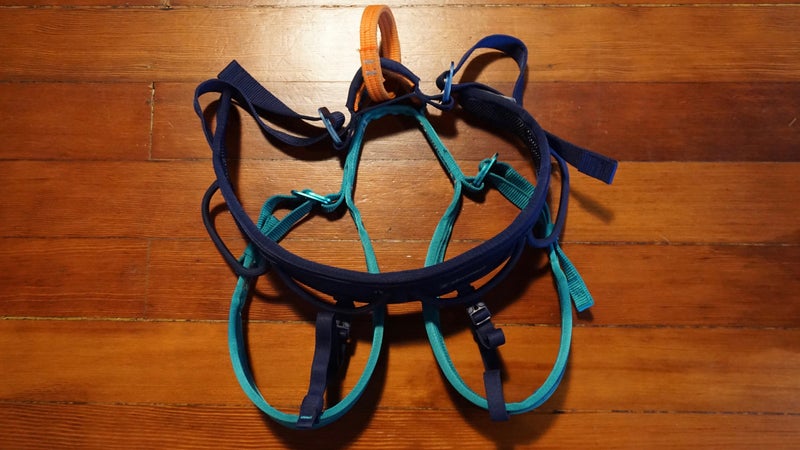
SimondÔÇÖs most basic harness, the , sells for $45, but I would recommend its╠ř╠řfor $55, which is just a couple bucks cheaper than a comparable harness, like . That $10╠řmakes a differenceÔÇöitÔÇÖs fully adjustable, has two tie-in points in the front, and four gear loops, whereas the Easy 3 uses a single tie-in loop and only has two gear loops. The extra loops are only╠řimportant if you plan on climbing outdoors, because youÔÇÖll most likely be carrying more gear (draws, protection, runners, webbing, etc.), but the single tie-in loop is the big kicker here; it makes the harness less comfortable, because the leg straps have to go all the way up to the waist belt╠řas opposed to leg straps that are connected by webbing, and will wear down quicker, because the single tie-in loop has to handle both belaying and tying in, so I suspect it will wear╠řdown twice as fast.
The climbing and mountaineering harness has an extra double-backed buckle on the waistband, which makes it more adjustable than the Easy 3. With the climbing╠řharness on, I didnÔÇÖt notice any place where it dug in or felt uncomfortable while╠řhanging in it for several minutes. It also gets bonus points for plastic buckles (compared to less user-friendly G hooks on harnesses like the Black Diamond Momentum) on the bungee straps, which come in handy if you need to use the bathroom.╠ř
Chalk Bag ($17)
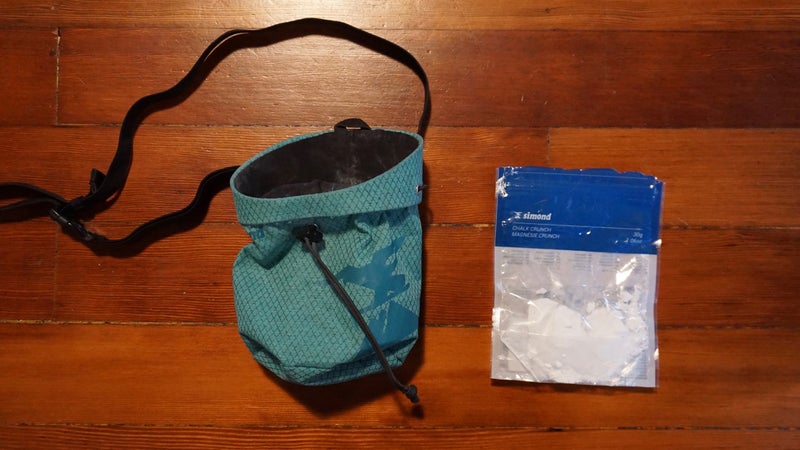
If youÔÇÖre looking for a simple, compressible chalk bag, look no further than . The╠řstiff rim and large opening make╠řit easy for your hand to get into╠řduring precarious rests on long routes, and the drawstring closure is easy to open and close with one hand. ThereÔÇÖs also a small elastic strap on the side for a chalk brush. The Diamond isnÔÇÖt SimondÔÇÖs , and there are╠řchalk bags from other brands with similar price points, but for a quality chalk bag,╠řanything under $20 is a good deal in my book.
IÔÇÖd recommend pairing this bag with a chalk ball, like the ╠ř($5), especially in a gym setting, where there are a lot of climbers in a closed space. Chalk bags can easily be stepped on or knocked over, and using a ball goes a long way to make sure your chalk actually stays put.╠řPlus, IÔÇÖve found that using a ball gives your hands a nice coat without over-chalking. ItÔÇÖs╠řeasy to apply, has a comfortable consistency, and works as it should.╠ř
╠ř
Belay Device and Carabiner ($20 and $10)
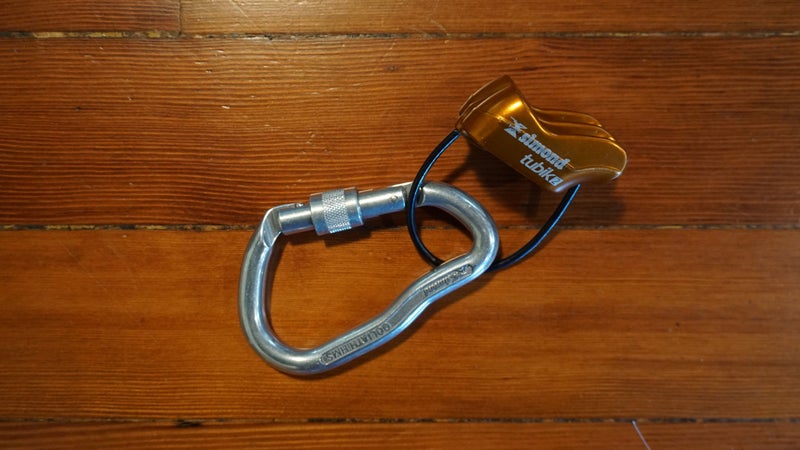
SimondÔÇÖs hardware prices arenÔÇÖt drastically different from╠řbrands you can find at retailers like REI or Backcountry. There are equivalents that are more expensive, but the difference is minimalÔÇögenerally $10.╠ř
ThereÔÇÖs nothing groundbreaking about DecathlonÔÇÖs belay device or locking carabiners, but thereÔÇÖs also nothing wrong with them. Its╠ř╠řclips and screws shut easily and is╠řjust as strong as most other carabiners,╠řwith a tested breaking strength of 25 kilonewtons╠řon the major axis (the average locking carabiner has a strength of 21 to 27 kilonewtons). The doesnÔÇÖt have a guide mode, so it wouldnÔÇÖt be my choice╠řfor multi-pitch climbs, but you donÔÇÖt need this feature for the gym or single-pitch sport routes. It also doesnÔÇÖt have an auto-locking feature, like the ,╠řso if your climber is hangdogging,╠řit becomes a little tedious. Otherwise, the device is easy to use and smoothly handles the rope.
╠ř
Optional Item: Rope ($70 for 35 Meters)
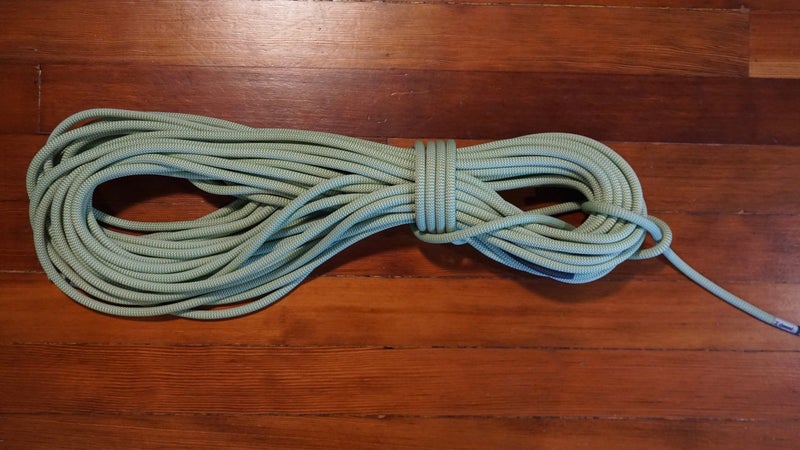
If you plan on lead climbing in a gym, many places require you to bring your own rope. First╠řcheck the height of your gymÔÇÖs wall. Indoors, you generally donÔÇÖt need a rope exceeding 40 meters╠řin length (unless your go-to gym is somewhere like , in Edinburgh, Scotland, or the , in Salt Lake City, which feature walls 21 to 30 meters high, in which case youÔÇÖd need a 50-to-60-meter rope). I wouldnÔÇÖt go shorter than 30 to 35 meters as a general rule of thumb. A 70-meter rope for indoor climbing would be excessive.
YouÔÇÖd be hard-pressed to find a 35-meter gym rope for less than this . The dynamic rope is rated for up to ╠ř(most gym ropes are rated between six╠ř▓╣▓ď╗ň ten╠řfalls)╠řand gives a comfortable catch. My climbing partner took a ten-foot fall, and the rope was springy enough to absorb the impact, making the fall easy for both climber and belayer.╠řThe ropeÔÇÖs static elongation (6.3 percent) is slightly lower than other comparable ropes, like the Black Diamond 9.9-millimeter rope (7.6 percent)ÔÇöthat means╠řyou lose less ground after taking a break at a bolt or on top rope, but it also might result in a less cushy fall.╠řMy one minor issue with Simond ropes is their tendency to get twisted and knotted during the first three to four uses. On the first use, even after flaking the rope twice, the rope knotted itself midclimb. After 10 to 15 climbs, the rope started to get less twisted, but itÔÇÖs something to be mindful of;╠řmaybe run it through a carabiner or belay device a few times to help it untwist.╠řAs a bonus, the 35-meter rope fits perfectly into the ($4), so you can╠řbring it╠řto the gym without the hassle of a lugging a huge bag.
The Bottom Line
DecathlonÔÇÖs climbing line performed well across the board. After taking the kit lead climbing and top-rope climbing in the gym, sport climbing outdoors on sandstone and granite, and bouldering in Yosemite, I donÔÇÖt have any major complaints that would lead me to discourage others from purchasing the gear. I was impressed with some features of its╠řshoes and harness, especially for the low price. If money isnÔÇÖt an object, and you want the absolute best, DecathlonÔÇÖs starter kit╠řisnÔÇÖt for you. However, if youÔÇÖre new to climbing or donÔÇÖt want to shell out a ton of money, DecathlonÔÇÖs collection is a solid place to start.
